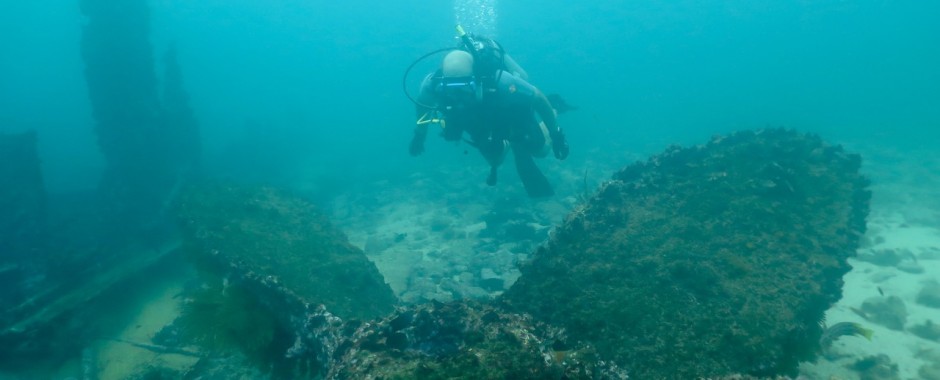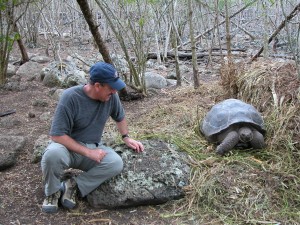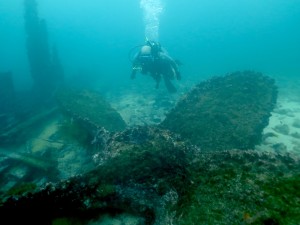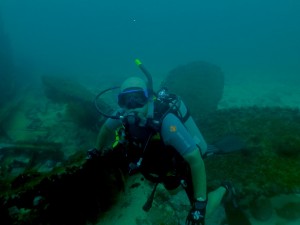BIO-SKETCH
Founding director of the Galapagos Initiative at the University of North Carolina at Chapel Hill, in association with the Universidad San Francisco de Quito; Dedicated (May 2011) the Galapagos Science Center, San Cristobal Island, Galapagos Archipelago, Ecuador – a facility for research, education, and community outreach and engagement programs in the Galapagos Islands; Galapagos Science Center is approximately 20,000 square feet in size, maintains a staff of 15 professionals, and contains a Microbiology & Genetics Lab, Terrestrial Ecology Lab, Marine Ecology Lab, and Spatial Analysis & Modeling Lab, in addition to faculty, staff, and student offices, conference room, community classroom, and equipment storage and outside terrace space for field experiments and teaching opportunities.
Through an extensive and intensive program of integrated and interdisciplinary research, the primary goals of the Galapagos Initiative are to understand the complex nature of population- environment interactions, challenges related to resource conservation and economic development, global interconnections, science, education, and knowledge transfer programs that benefit UNC-Chapel Hill, our collaborators, and the global community, inform policy and management through investigative and integrative science, develop, and translate research technologies to industry and government, and develop insights and understandings to address the cross-cutting challenges that face science, society, and the Galapagos Islands. In addition, the Galapagos Initiative has created a global template for the study of other conflicted and challenged places around the globe located in and around protected areas and in the many diverse environments in which social and ecological sustainability is at risk.
As the crowning event of the 10-year anniversary of the Galapagos Science Center, a strategic partnership between the University of North Carolina at Chapel Hill and the Universidad San Francisco de Quito, a World Summit on Island Sustainability was conducted by organizer, Stephen J. Walsh, and held on June 26-30, 2022 on San Cristobal Island, Galapagos Archipelago of Ecuador. The intent of the World Summit was to bring together leading experts on island ecosystems and particularly on island sustainability from across the globe to represent a diversity of perspectives and stakeholders. The World Summit was exclusive and global and featured an “expert convening” of scholars and practitioners to address island vulnerability, resilience, and sustainability.
Founder of the International Islands Network-of-Networks (I2N2), designed to create a network-of-networks focused on global island ecosystems and the threats to sustainability, is being developed to catalyze linkages among existing and nascent networks to integrate researchers across disciplines, institutions, and nations to examine the risk to global oceanic islands from social-ecological-biophysical stressors and climate change on island sustainability. The I2N2 will support a community of scholars focused on developing collaborative island research and education programs with an emphasis on the multi-thematic, multi-scale, and multi-dimensional threats to island sustainability as well as local populations and diverse stakeholder groups.
The development of the I2N2 is leveraged through the strategic partnership in the Galapagos Islands of Ecuador established by Professors Stephen J. Walsh, University of North Carolina at Chapel Hill (UNC) and Carlos F. Mena, Universidad San Francisco de Quito (USFQ). The joint UNC-USFQ Galapagos Initiative is best defined through the joint development of the Galapagos Science Center (GSC), located on San Cristobal Island in the Galapagos Archipelago of Ecuador. Officially dedicated in 2011 by the leadership of both campuses, the GSC is a facility dedicated to interdisciplinary science through a facility that is 20,000 square feet in size and nearly 125 affiliated scientists, including, faculty, students, and staff from global institutions that are members of the International Galapagos Science Consortium. Further, as the crowning event of the 10-year anniversary of the Galapagos Science Center, a World Summit on Island Sustainability was held in June 26-30, 2022 on San Cristobal Island that featured nearly 150 scientists brought together to address a host of critical questions on island sustainability. Papers from the World Summit were published in the Galapagos Book Series (Walsh & Mena, Series Editors) by Springer Nature, Island Ecosystems: Challenges to Sustainability, Stephen J. Walsh, Carlos F. Mena, Jill R. Stewart, Juan Pablo Munoz Perez, Guest Editors. Currently, the Galapagos Book Series includes 11-volumes on a host of social, terrestrial, and marine topics critical to assessing the Galapagos Islands and the forces of change.
In sum, I2N2 will foster focused innovation and targeted use of limited resources for maximum benefits to understand the challenges to international island sustainability and possible solutions. Drawn from global scientists and practitioners, I2N2 will document the development of shared research priorities among existing networks, perceptions of the value of the network-of-networks, along with the challenges, barriers, and efforts needed to initiative a plan and implement it through a functional and operational program. Led by interdisciplinary teams, I2N2 will foster collaborative research opportunities by coordinating the networks through a series of focused, cross-disciplinary conversations and activities. Ultimately, I2N2 will promote the awareness of the challenges to island sustainability that are imposed by exogenous and endogenous forces of change that are mediated by the interactions among social, biophysical, and ecological forcing functions that affect island sustainability. The project will link social, natural, spatial, and computational scientists, junior and senior scholars, national and international institutions, and their networks to facilitate the development of strategic linkages among people, institutions, and networks that accelerate the process of exploration, discovery, communication, and training of next generation scientists and practitioners. We will also leverage research and education resources and interdisciplinary talents among global networks that require coordinated international efforts and an interdisciplinary focus. The gathering of a host of global island scholars with diverse stakeholders in one place and at one time will be fundamentally important to the establishment of I2N2. Mapping a landscape, forging and deepening alliances, discovering a path forward, and accelerating action will be critical, particularly, as island ecosystems respond and adapt to diverse forces of change that are threatening their very existence.
Fulbright Scholar (2011-2015), Council for International Exchange of Scholars, Specialists Program – Accepted an invitation to the University of the Sunshine Coast, Queensland, Australia (2012), lectures presented at University of the Sunshine Coast, Griffith University, and Queensland University of Technology; Participated in “Workshop on Climate Change, Social-Ecological Dynamics, and Tourism in Iconic Protected Areas.”
Invited Project Scientist, Chinese Academy of Sciences, Institute for Geographic Sciences and Natural Resources Research (IGSNRR) (2012-2013); Distinguished Teaching Award for Post- Baccalaureate Instruction, University of North Carolina at Chapel Hill (2008); Awarded Honors for Lifetime Achievement, Southeastern Division of the Association of American Geographers (2007); Elected Fellow, American Association for the Advancement of Science (2006); Edward J. Taaffe Distinguished Lecturer, Department of Geography, Ohio State University (2004); Ida Beam Distinguished Visiting Professor, Department of Geography, University of Iowa (2002); Elected President (2003-2005), Vice-President (2000-2002), and Secretary (1992-1994), Southeastern Division of the Association of American Geographers; Awarded National Research Honors for Distinguished Scholarship, Association of American Geographers (2001); Awarded Research Honors, Southeastern Division of the Association of American Geographers (1999); Awarded Outstanding Contributions Award and Medal from the Remote Sensing Specialty Group of the Association of American Geographers (1997); Named the Amos H. Hawley Professor at the University of North Carolina at Chapel Hill (1993-96); Served as Director, Spatial Analysis Unit, Carolina Population Center (1992-97), and faculty advisor to the Spatial Analysis Unit (2000-present); Elected Chair of the Geographic Information Systems (1998-2000) and Remote Sensing (1994-1996) Specialty Groups of the Association of American Geographers.
Served on the Editorial Boards of the Annals of the Association of American Geographers, GeoCarto International, Plant Ecology, Journal of Geography, The Professional Geographer & Southeastern Geographer; Served on the Dissertation Improvement Panel for the Geography and Regional Science Division of the National Science Foundation (1997-1999); Member of Review Panels, National Institutes of Health (2001, 2005); Member, Committee of Visitors, National Science Foundation (2003).
Launched a Book Series on the Galapagos Islands, with Springer Nature, Series Editors (S.J. Walsh & C.F. Mena); Social, Terrestrial, and Marine Interactions in the Galapagos Islands (2012):
- Science and Conservation in the Galapagos Islands: Frameworks & Perspectives (2013), Stephen J. Walsh & Carlos F. Mena, Guest Editors
- Evolution from the Galapagos: Two Centuries after Darwin (2013), Gabriel Trueba & Carlos Montufar, Guest Editors
- The Galapagos Marine Reserve: A Dynamic Social-Ecological System (2014), Judith Denkinger & Luis Vinueza, Guest Editors
- Darwin, Darwinism and Conservation in the Galapagos Islands (2017), Diego Quiroga & Anna Sevilla, Guest Editors
- Sustainable Energy Mix in Fragile Environments – Frameworks and Perspectives (2018), Mary E. Tyler, Guest Editor
- Disease Ecology: Galapagos Birds & their Parasites (2018), Patricia G. Parker, Guest Editor
- Understanding Invasive Species in the Galapagos Islands: From the Molecular to the Landscape (2018), Maria de Lourdes Torres & Carlos F. Mena, Guest Editor
- Urban Galapagos – Transition to Sustainability in Complex Adaptive Systems (2019), Thomas Kvan & Justyna Karakiewicz, Guest Editors
- Land Cover/Land Use Change on Islands: Threats to Sustainability (2020), Stephen J. Walsh, Diego Riveros-Iregui, Javier Arce-Nazario, Philip H. Page, Guest Editors
- Water, Food, and Human Health in the Galapagos, Ecuador (2022), Amanda L. Thompson, Valeria Ochoa-Herrera, Enrique Teran, Guest Editors
- Island Ecosystems: Challenges to Sustainability (2023), Stephen J. Walsh, Carlos F. Mena, Jill R. Stewart, Juan Pablo Munoz Perez, Guest Editors.
Co-Editor of Special Issues: Journal of Vegetation Science (1994), Photogrammetric Engineering & Remote Sensing (2002, 2008), Geomorphology (2003, 2011), GeoForum (2008), Journal of Land Use Science (2008), Journal of Remote Sensing (S.J. Walsh & C. Song) (2019).
Co-Edited a series of books for Kluwer Academic Publishers – “GIS and Remote Sensing Applications in Biogeography and Ecology,” (2001); “Linking People, Place, and Policy: A GIScience Approach,” (2002); and “People and the Environment: Approaches for Linking Household and Community Surveys to Remote Sensing and GIS,” (2003); Co-Editor for Elsevier, “Mountain Geomorphology – Integrated Earth Systems,” (2003); “The Changing Alpine Treeline,” (2009); and “Geospatial Technologies and Geomorphological Mapping,” (2012); Editor for Elsevier, “Remote Sensing Applications for Society Benefits,” (2017).
RESEARCH OVERVIEW
My research examines coupled human-natural systems and land use/cover dynamics in the frontier environments of the Northern Ecuadorian Amazon and the Galapagos Islands. This research recognizes that at local, regional, and global scales land use changes are significantly altering land cover types and their spatial structures, perhaps at an accelerating pace. This transformation of the Earth’s surface, particularly through deforestation, agricultural extensification, secondary forest succession, and urbanization, is linked to a variety of scientific and policy issues articulated by international organizations, such as, the International Human Dimensions Program and the International Geosphere-Biosphere Program. In addition, program initiatives of the National Science Foundation (e.g., Coupled Natural-Human Systems Program), National Aeronautics and Space Administration (e.g., Land Cover/Land Use Change Program), and the National Institutes of Health (e.g., National Institutes for Child Health and Development Program and the former Roadmap Initiatives) revolve around the human dimensions of land use/cover change and the proximate/distal causes & consequences of such changes.
Finally,myresearchfocusesonlandscapecharacterizationthroughstatisticalandspatialmodelingandspatialanalysisapproaches.Geospatial data and spatial digital technologies and approaches are developed and applied to study ecological systems and linked social-ecological systems.
Of particular interest are new developments in complexity theory that conceives the world as consisting of self-organized systems, either reproducing their state through negative feedbacks with their environment or moving along trajectories from one state to another as through positive feedbacks.
Biocomplexity combines social-ecological co-evolution and adaptive resilience to study coupled human-natural systems. Biocomplexity is described as the “properties emerging from the interplay of behavioral, biological, chemical, physical, and social interactions that affect, sustain, or are modified by living organisms, including humans” – it encompasses the complex interactions within and among ecological systems, the physical systems on which they depend, and the human systems with which they interact. My research in biocomplexity and system dynamics are motivated by questions that seek to understand the following broad areas of concern:
- How does a complex systems approach help explore the internal mechanisms of system dynamics and provide plausible explanations?
- How do results derived from applying complexity theory help in understanding decision-making across levels of social organization ranging from individual households to national governments?
- How do fundamental characteristics of complex dynamics of coupled natural-human systems limit their predictability, sustainability, and resilience?
- How can economic development and resource conservation be reconciled, and how can social and ecological systems adapt, leading to sustainability?
- What are the impacts of climate change on the behavioral shifts and adaptive capacities of social, terrestrial, and marine systems?
- Can Agent Based Models be used to explore the environment as well as scenarios of land use/land cover dynamics by integrating the characteristics of agents (e.g., individuals and households), a changing environment, neighborhood associations, and interaction rules?
- Can the goal of exploring “what if scenarios” of land use/cover change through spatial simulations provide links between theory and model outcomes, and trajectories of land change set by the pathways of human-environment interactions?




